Click to email me
A Day Out at:

Buckfast Abbey is in Devon and is as ancient as "hell" although the current abbey has not been built all that long.
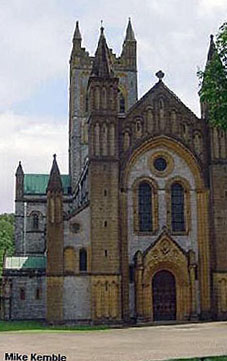
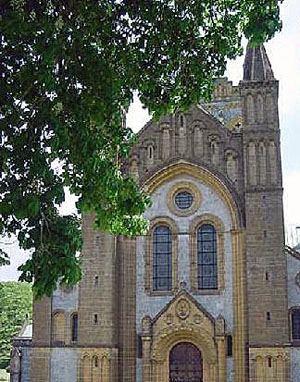

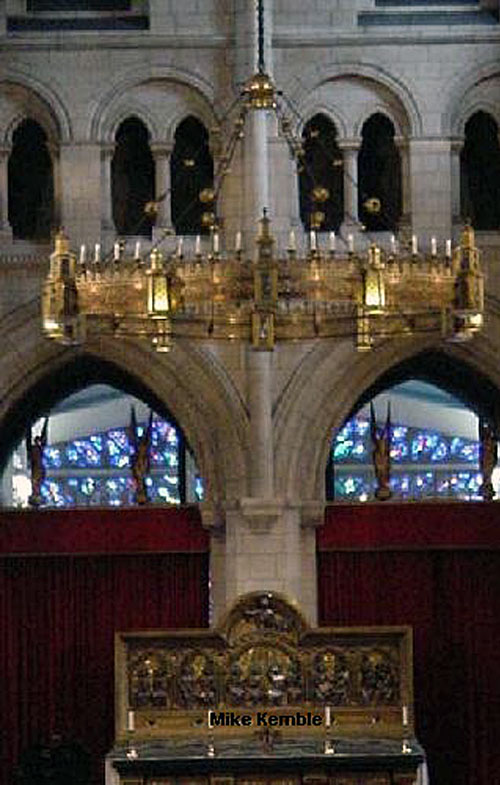
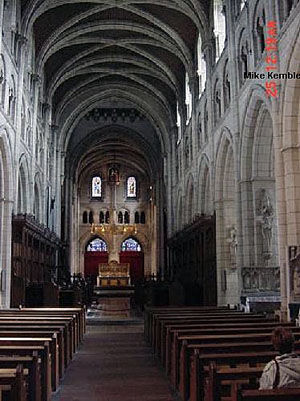
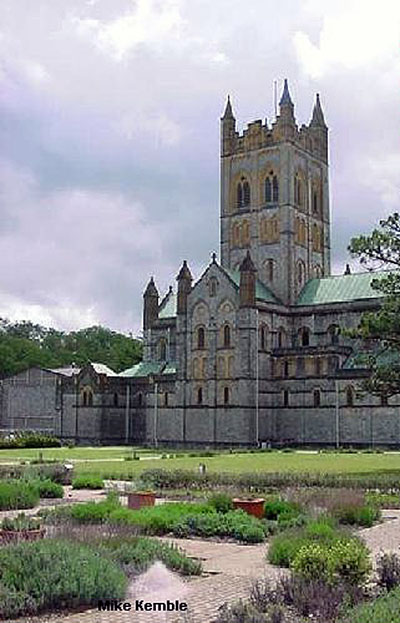
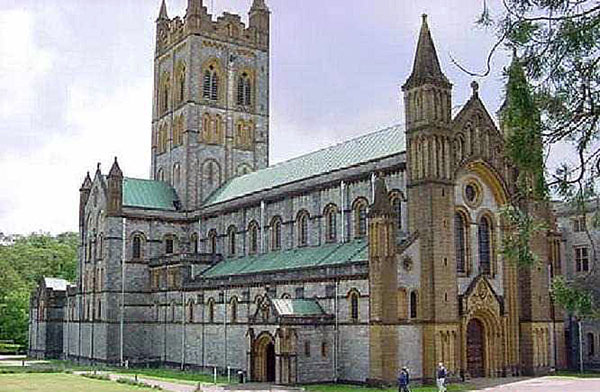
The following is an extract from their own extensive web site.
I recommend a visit to:
http://www.buckfast.org.uk/index.htm
|
The history of Buckfast Abbey is extraordinary, since it is the only English medieval monastery to have been restored and used again for its original purpose. The Saxon Monastery The original monastery at Buckfast was founded during the reign of King Cnut in 1018. The first Abbey was Benedictine. In comparison with the fifty or so other abbeys in 11th century England, Buckfast was small and unprosperous. The rule of life which they followed was the "Regularis Concordia", drawn up at Winchester in about 970 for all Benedictine monasteries in England as part of re-establishing monastic life. We do not know for sure exactly where the Saxon monastery stood. A site near the river would possibly have been more convenient when one considers the small size of the Abbey. However, as today, there would have been the danger of flooding. During the excavations of the 14th century Guest Hall, a fragment of stone was discovered which may originally have been part of the Saxon church, but no other evidence of the Saxon monastery has so far been found. Buckfast in the Domesday Book To ensure its survival as a place of prayer, the founders of the little Saxon monastery endowed it with property throughout the region. We can gain an idea of these endowments by looking at the "Domesday Book", which although drawn up in 1086, related to the state of things which existed "on the day when King Edward (the Confessor) was alive and dead", i.e. in 1066. This was only 48 years after Buckfast's foundation, so it probably represented the state of the Abbey and its possessions in their earliest form. Buckfast and the Savignac Rule For about fifty years after 1086, when the Domesday Book was written, Buckfast's history is obscure, but it seems likely that the house was in decline at this time. Henry I had confirmed the Abbey and its possessions at the beginning of his reign, but in 1136, King Stephen (who was sympathetic to monasteries, establishing and revitalizing many of them during his reign) gave Buckfast to the Abbot of Savigny, who chose a monk from his own monastery to lead a group across the Channel and establish the Savignac rule at Buckfast.It is unknown how the remaining members of the Saxon community took to the new Savignac rule. However, there was soon to be a more drastic change, when Buckfast joined the Cistercian Order in 1147 Cistercian Buckfast The reforms of the monastic observance which led to the new Cistercian Order were started at the abbey of Citeaux at the beginning of the 12th century. The Cistercian observance was conceived as a return to the Rule of St. Benedict in its original, austere form. The Divine Office now occupied six hours, and began with a service in the small hours of the morning. The elaboration of the Gregorian Chant was replaced with a new simplicity. All luxuries were swept away, and the churches were stripped of ornaments. The rule of silence was re-affirmed, and a vegetarian diet enforced. The characteristic Cistercian white habits were made from natural, undyed wool. Buckfast became a Cistercian abbey in 1147. There was an immediate and fundamental transformation. The whole monastery was rebuilt in stone, in the Cistercian pattern. When the present monks returned to Buckfast in 1882, they were able to uncover almost all of the original foundations dating back to this period, and rebuild the Abbey in the architectural style of the mid-twelfth century - effectively restoring the original Cistercian abbey. Archaeological excavations in the outer court (1982 - 1990) have shown that the whole precinct probably dates back to this period. The arch of the north gate and part of the barrel-vaulted undercroft by the west cloister are now the only buildings to survive (above ground) from the original 12th century Cistercian abbey.
After a brief spell of trouble during the reign of King John, during which time England was placed under an Interdict by the Pope, Buckfast entered a long period of relative stability. A small chapel - possibly a Lady Chapel - was added at the eastern end of the church, and quantities of 13th century floor tiles, tracery and Purbeck marble columns excavated in the late 19th century indicate further building work in the cloisters, chapter house and refectory. The 13th century was perhaps one of the peak periods in the Abbey's history. This was the time when the influence of the Cistercians made itself felt in the area, and indeed in the country as a whole. As owners of large areas of land, the Cistercians became the country's main wool producers, setting up the industry which was to lead to England's great wealth in the later Middle Age. In 1236, the Abbot and his monks were admitted to the guild of Totnes merchants. In 1315, Buckfast was listed along with Forde, Newenham and Torre Abbey as an exporter of wool to Florence, although it is likely that, in line with most Abbeys in the country, Buckfast was sending wool to Italy by the end of the previous century. Remaining Evidence of Farming Activities Some evidence of the farming activities of the Buckfast monks still survives. A short distance up the road from the North Gate is the Abbey's grange barn, now converted for residential use, where the monks would have threshed and stored their corn. On Dartmoor itself, another grange was excavated by Aileen Fox in 1956 on Dean Moor, before the area was flooded by the construction of the Avon Dam. This small homestead was used to keep a lay-brother in continual residence with a shepherd to help him, until the time of the Black Death (1348-50). The Black Death Excavations in the Outer Court between 1982 and 1990 may cast some light on the effects of the Black Death at Buckfast. Many of the buildings around the Abbey show signs that they either fell down or became disused in the mid 14th century, including the almshouse beside the South Gate, which appears to have burnt down, standing abandoned for many years before being re-roofed and used as a stable. The social necessity for an almshouse would have been reduced after the Black Death as housing was plentiful and, with labour in short supply, wages were high. The Abbey's disused buildings remained in this state for about thirty years, which was about as long as it took for the economy to recover. Buckfast as a Wealthy Landowner By the 15th century, Buckfast had become a wealthy landowner and a pillar of the establishment. Nevertheless, it had not lost sight if its social responsibilities, running its own guest hall, almshouse and school, as well as maintaining its parishes and manors, and establishing fairs and markets to encourage local trade. Building Work at Buckfast The Abbot in the early years of the 15th century was William Slade, reckoned by some to have been one of the most distinguished of the Cistercian Abbots of Buckfast. Before joining the Community at Buckfast, Slade had had a fine academic career at Oxford. Fifteen years after coming to Buckfast, he was elected Abbot. Whilst he will have undoubtedly improved Buckfast's standing as a centre of learning, he was also a builder. Slade is credited with much of the building work at Buckfast. The inspection of the foundations in 1884 indicates that Slade rebuilt the north cloister, and stonework discovered at the base of the church tower at this time, also indicates that it was rebuilt in the 15th century. More recently, archaeologists have dated the complete rebuilding of the South Gate and its attached range to this period. Another important Abbot of this time was Abbot Kyng. Kyng was appointed Abbot in 1467. Although there is very little documentary evidence Abbot Kyng, it would appear that he was responsible for the rebuilding of the Chapter House, and two of the most impressive medieval buildings still standing at Buckfast probably date from his Abbacy. One of these buildings is the south wing of the Guest Hall, which has survived almost unchanged, and was restored to its original appearance in 1992. Another is the "Abbot's Tower" at the south-western corner of the conventual buildings. This was a series of three small but very well-appointed rooms adjoining the western range. Each room had the luxury of its own fireplace and garderobe en suite, suggesting that the "Abbot's Tower" was probably for the Abbot's most important guests, or for corrodians. Gathering Clouds - The Dissolution of the Monasteries By the beginning of the 16th century the monasteries in England, although generally very rich, were in decline. At Buckfast in the 12th century, there may have been as many as 60 choir monks, and perhaps twice as many lay-brothers; between 1500 and 1539, only 22 monks were ordained, ten of whom remained at the Dissolution and signed the deed of surrender. Historians have tended to view monasteries of this period as being corrupt, as well as being lax in their religious and charitable duties. However, some modern historians now dispute this. Whatever state the monasteries were in, King Henry VIII had his eyes on the wealth which they possessed. In 1535, he appointed a new Vicar General, Thomas Cromwell, with instructions to visit and reform the houses of the religious orders. Only a year later, the smaller monasteries in England had been closed down, with this essentially financial decision justified on the grounds that they were centres of "manifest sin, vicious, carnal and abominable living" - a conclusion not supported by the Visitor's reports. For Buckfast, the fateful day arrived on 25th February, 1539. The king's commissioners, led by a select group of some five distinguished lawyers, had been travelling around the country for the past twelve months closing monasteries as they went. Two of them, William Petre and John Tregonwell, turned their attention to the West Country in January 1539. In Exeter, they separated in order to "clean up" the remaining monasteries in Devon and Cornwall. William Petre was at Torre Abbey on the 23rd, and Buckfast on the 25th, before continuing to Buckland (27th) and Plympton Priory (March 1st). They met again in Dorset on March 8th to close Forde Abbey. In four months, these two men had visited and closed forty monasteries. During each brief visit they will have presented and witnessed the signing of the Deed of Surrender, assigned pensions to the monks, and taken possession of the Abbey's seals, charters, and church plate. After this particular campaign, they delivered 1.5 tons of gold, gilt and silver to the Tower of London, which included the treasures of Buckfast Abbey. Sharing the Spoils After the Dissolution, the land which Buckfast had formerly owned became the property of the King. The tenancy agreements did not change to any great extent; for most people, the Dissolution just meant a change of Landlord. During the next few years, however, some of the Abbey's manors were bought from the King. William Petre for example, who had been present at the signing of the Dissolution charter, bought the largest and most prosperous manors of South Brent and Churstow. The Abbey itself was immediately vacated, and it seems that the church and monastic buildings were stripped and left to decay. Lead was melted down, furniture and removables auctioned, and the Abbey's five bells were bought by the parishioners of Buckfastleigh. Many of the smaller buildings in the Outer Court were retained and converted for different uses. Buckfast Without The Abbey Tracing the history of Buckfast for the two centuries following the Dissolution is difficult. The archaeology of the buildings in the former Outer Court shows that they remained largely unchanged until the early 19th century. Even as late as 1793, the ruins of the former Abbey were still very much in evidence, and remained so until the site was bought by Samuel Berry in 1800, who cleared most of the rubble away to make way for the building of a mansion house on the site. Berry retained the Abbot's Tower and the 12th century undercroft, but the rest of the Abbey was flattened. Over the next eighty years, the Buckfast site changed hands four times, finally falling into the hands of Dr. James Gale in 1872. Ten years later, Dr. Gale decided to sell the property, but was keen to offer it a religious community. An advert was placed in The Tablet, describing the Abbey as "a grand acquisition could it be restored to its original purpose." Six weeks later, monks were again living at Buckfast after a gap of 343 years. The Return of Monastic Life The monks who returned to Buckfast came here by a very roundabout route, for they were exiled from their own monastery in France, and eventually made their way to England. They were given shelter by the community of St. Augustine's Priory (later Abbey) at Ramsgate, who loaned them a large property in Leopardstown on the outskirts of Dublin. Two years later, they noticed the advert in The Tablet, and the superior, Pere Duperou, travelled with Dom Adam Hamilton (a monk of Ramsgate, who acted as translator) to Plymouth, where they met Dr. Gale. They immediately took out a lease on the property. The first six monks arrived at Buckfast on 28th October, 1882. The remainder arrived during the next few weeks. The Discovery Of The Foundations Much public interest and support was shown for the monks' plans to restore the Abbey. Mr. Frederick Walters, one of the leading architects of his day, was appointed to draw up plans for the restoration, which he did using the evidence of the Buck print of 1734 (a picture of the ruins of the Abbey at that time), and the few ruins still standing. As it turned out, Walters' original plans for the restored Abbey Church turned out to be wrong, for shortly after Walters made his proposal, one of the monks discovered part of the medieval foundations whilst digging in the vegetable garden. The monks then uncovered most of the rest of the foundations of the 12th century Cistercian Abbey. Substantial foundations of the domestic buildings were being uncovered as late as 1997. By March 1884, Walters had made accurate drawings of the foundations, and put forward another design for the rebuilding of the Abbey in the style of the mid-12th century, based on studies of other Cistercian Abbeys such as Kirkstall and Fountains. The Building of the Monastery In the meantime, work was under way to improve the monastery buildings. The Abbot's Tower had been restored, and a temporary church (now the Chapter House) had been erected next to it. This was opened on 25th March, 1884. Also in 1884, work started on the South Wing of the monastery, which was to include the kitchen, refectory and cloister, mostly paid for by Lord Clifford of Chudleigh. Monastic Life at Buckfast During The Early Years Life at Buckfast in the early years was quite austere - this was a legacy from the Abbey's origins in France. The 2-00am Night Office was retained until 1933; silence was strictly observed in the monastery, leading to the use of traditional monastic sign language; monks knelt when speaking to the Abbot, and newspapers were a rarity. Abbot Boniface Natter Boniface Natter was blessed as Abbot on 24th February, 1903 - by pure coincidence, exactly 365 years after the closure of the medieval Abbey. After the blessing, a cheque was found in the collection basket for £1,000. This money was used to complete the West Wing of the monastery, providing much-needed bedrooms, as well as rooms for the novitiate. Abbot Natter also arranged for the medieval statue of Our Lady of Buckfast to be restored. The lower part of the statue had been discovered in an old wall, still retaining its original colouring and gilding. This is now in the Lady Chapel of the Abbey Church. (A picture of the upper part of the statue can be seen on the Abbey Church page). Abbot Natter was tragically drowned in a shipwreck in 1906. Anscar Vonier, who had been with Natter at the time of the shipwreck, managed to survive. Shortly after his return to Buckfast, Anscar Vonier was elected as the new Abbot. Abbot Anscar Vonier And The Restoration Of The Abbey Church Soon after becoming Abbot, Vonier announced to the community that his first project would be to rebuild the Abbey Church. Br. Peter Schrode, who had been sent to a monastery in France to learn the art of masonry, was to lead the project. On January 5th, 1907, the whole community gathered at the north-east corner of the foundations, and watched as Abbot Anscar laid the first stone. The Abbey Church was built piecemeal, according to the funds available - but at no time did work come to a halt until the whole church was completed, thirty-two years later. The builders - normally only four monks, and never more than six - began with the east end, the sanctuary, transepts and two bays of the nave. At first, while funds were low, all the stone had to be cut and dressed by the monks. In later years, they were able to buy the stone ready-dressed from the quarries. Scaffolding was made from wooden poles, lashed together with ropes and chains. Stone was lifted with manual hoists or block and tackle. The building work continued throughout the First World War, during which time the community (two-thirds of whom were German) were prohibited from leaving the monastery without special licence, as well as having to endure the hostility of some of the local population. Nevertheless, funds still came in. In 1910, Sir Robert Harvey donated a peal of fourteen bells. Most of the furnishings in the church were also donated by individuals, such as the Stations of the Cross, the stone carvings on the altars in the side-chapels, the stained glass, candelabra, and the great Corona Lucis above the sanctuary. (Pictures of the canelabra and the Corona Lucis can be seen on the Abbey Church page). The Consecration 25th August, 1932 was the day chosen for the Consecration of the Abbey Church. After 25 years of labour, all but the upper section of the tower had been completed. Cardinal Bourne was chosen by the Pope as his representative; also taking part were five Archbishops, sixteen Bishops, thirty Abbots and many priests and religious. Not only was the Church full to capacity, but thousands heard the service outside, where loud speakers had been installed. The service was also broadcast by the B.B.C. The final phase of the rebuilding of the Church was the completion of the tower to accommodate the superb set of bells which had been donated in 1910. The final stone was laid on the tower on 24th July, 1937, completing thirty-two years work. It was not until December of the following year that the pointing was finished and the scaffolding removed. The Rebuilding Completed - Abbot Anscar Dies Abbot Anscar was away on a lecture tour in the last weeks of 1938, returning on December 6th. The builders had hurried to remove the last of the scaffolding for his return, so that Vonier, exhausted and ill with a cold he had caught on the long journey home, could see the great work completed. He died three weeks later. Abbot Anscar was internationally known as a writer, preacher and scholar, but it was his life's work as a builder that he was best known. One writer in the Telegraph recalled a conversation that they had recently had with Vonier, in which Vonier had said, "Once the Church is completed and the whole building finished, I have done my task and I can go." Abbot Anscar was buried in the Church. A Bronze memorial plaque, showing the achievements of Vonier's life was made by Benno Elkan, and erected in the south aisle. Abbots of Buckfast Buckfast was first established as a Monastic Settlement in A.D. 1018 Benedictine Abbots: Alwin (Aelwinus) first mentioned as having attended Shire-mote in Exeter in about 1040. Known from the Doomsday Book to have been Abbot in 1066. Eustace first mentioned in 1143 in a Totnes Deed. He was Abbot when Buckfast was affiliated to the Abbey of Citeaux (Cistercian). Cistercian Abbots: Buckfast still followed the Rule of St. Benedict, as the Cistercians also live by that Rule. William acted as Papal Legate in 1190. Nicholas elected in 1205. Michael mentioned in the Cartulary of Buckfast Abbey (C.B.A.) in 1223. Peter (I) mentioned in the C.B.A. 1242. William (II) mentioned in the C.B.A. 1249. Howell mentioned in the Leger Book (L.B.) of Buckfast (Brit. Mus.) - no dates. Henry mentioned in C.B.A. 1264 and 1269. Simon mentioned in C.B.A. and Petre Archives (P.A.) between 1273 and 1280. Robert mentioned in L.B. and Exeter Episcopal Registers (Ep. Reg.) between 1280 and 1283. Peter de Colepitte mentioned in the P.A. between 1291 and 1313 Robert II mentioned in the Ep. Reg. 1316. William Atte Slade mentioned in the Banco Rolls 1327. Stephen I mentioned in the Ep. Reg. 1328. John of Churchstowe mentioned in the Ep. Reg. 1332. William Gifford mentioned in the Ep. Reg. 1333. Stephen of Cornwall mentioned in the Ep. Reg. 1348. Philip (Beaumont) mentioned in the Ep. Reg. 1349. Robert Symons mentioned in the Ep. Reg. and P.A. between 1355 and 1390. William Paderstow mentioned in the Ep. Reg and P.A. 1395. William Slade mentioned in the Ep. Reg. and by Leland - "Com. de Scriptoribus Britanniae" and Boase - "Annals of Exeter College, Oxford" between 1401 and 1415. William Beaghe mentioned in the Ep. Reg. and P.A. between 1415 and 1432. Thomas Roger mentioned in Ep. Reg. and P.A. He was Prior Adminstrator c. 1422 - 1432, and blessed as Abbot in 1432. John Ffytchett mentioned in the Ep. Reg. 1440. John Matthu (Matthew) mentioned in the Ep. Reg. 1449. John King mentioned in the Statuta Cap. Gen. Ord. Cist. from 1464 to 1498. John Rede (I) mentioned in the Ep. Reg. 1498. John Bleworthy mentioned in 1505 - Cal. of Early Chancery Proceedings, also in Powderham MSS. Alfred Gyll mentioned in the Ep. Reg. 1512. John Rede (II) mentioned in the Ep. Reg. 1525. There is no record of death or resignation from his office. Gabriel Dunne (or Doone) imposed on the Community in 1535 by Thomas Cromwell (State papers).He surrendered the Abbey to the King on 25th February, 1539. Monastic Life restored at Buckfast in 1882. Thomas Duperou Superior, 1882 till 1884 (becomes Abbot of Sacred Heart, USA) Leander Lemoine Superior 1884 till 1885 Benedict Gariador Prior, August 1885, till February 1899 Leander Lemoine Superior, March 1899 Ignatius Jean Superior, April 1899, till March 1900 (not a Monk of Buckfast) Leander Lemoine Superior, March 1900, till July 1902 (was also Abbot Visitor) Savinian Louismet Superior, July 1902, till November 1902 Benedictine Abbots: Boniface Natter elected 19th November, 1902. Died 4th August, 1906. Anscar Vonier elected 14th September, 1906. Died 26th December, 1938. Bruno Fehrenbacher elected 10th January, 1939. Resigned 1956. Titular Abbot of Tavistock till his death on 18th July, 1965. Placid Hooper elected 5th January 1957. Ruling Abbot till 1976.Titular Abbot of Tavistock till his death on 11th December, 1995 Leo Smith elected 30th January, 1976. Ruling Abbot till 1992. Titular Abbot of Colchester till his death on 10th July, 1998 David Charlesworth elected 3rd January, 1992. Ruling Abbot till 1999. Titular Abbot of Malmesbury. Sebastian Wolff Appointed Prior Adminstrator in January 2000 |